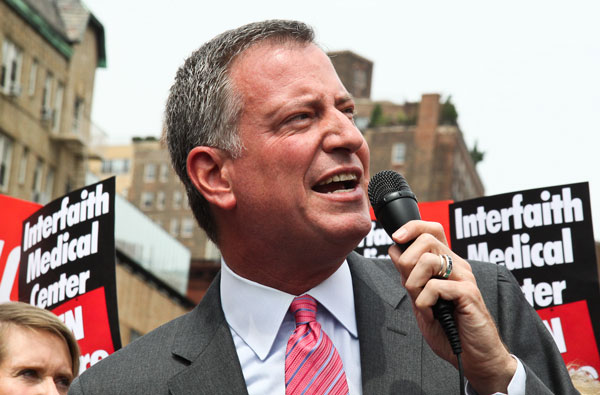Across the city, community boards and housing activists are rejecting two sweeping zoning proposals by Mayor Bill de Blasio. On Wednesday, there was an overwhelming turnout at a City Planning Commission hearing, where the public could offer testimony, and the commissioners definitely more than got an earful. More than 300 people filled the meeting. A few hundred more were unable to get in.
Basically, the two proposals — called Zoning for Quality and Affordability and Mandatory Inclusionary Housing — can, on the one hand, be seen as well-intentioned efforts to help create affordable housing, which has been one of de Blasio’s oft-stated and admirable top goals. However, the question is whether the so-called “trade-off” — in increased height and bulk — needed to create these affordable units is so negative that most New Yorkers oppose the two plans.
Overwhelmingly, community boards — which are the de facto voices of their communities — housing activists and community groups, along with some politicians, including Assemblymember Deborah Glick and Councilmember Rosie Mendez, have come out against these “one size fits all” plans.
Z.Q.A. would apply citywide to what are known as contextually zoned districts, where height caps currently exist. These caps would be increased from around 5 to 10 feet in contextual zones and, additionally, up to 25 feet in inclusionary zones — where developers get a height boost as an incentive to voluntarily build affordable housing — with the city’s argument being that this would allow developers to include affordable housing and community facilities in their projects that they currently often don’t have space for under outmoded zoning.
Yet, the districts where this zoning would apply are contextually zoned for a reason — in many cases, residents, community groups and local representatives worked long and hard, over years, to craft community-led rezonings in these areas. For the city now to come along and summarily boost the heights is simply wrong. It’s laudable to create conditions that allow for more affordable housing. Yet, at the end of the day, it simply seems to us that Z.Q.A. is being pushed to benefit the developers, to allow more market-rate units.
As for M.I.H., again, in theory, it’s a great idea to require developers to include 25 percent to 30 percent permanently affordable housing for any large swaths of the city — or even specific, individual building sites — that are undergoing a rezoning. If passed, this would be the country’s most far-reaching mandatory inclusionary affordable housing plan.
For an idea of what this plan would mean, one needs to look no further than the sprawling St. John’s Partners project being proposed for the Lower West Side, across from Pier 40, at West and Houston Sts. Of this project’s 1,586 residential units, 476 would be permanently affordable. Of that amount, 175 would be for low-income seniors; the rest would be for low- and moderate-income families.
In return for St. John’s Partners providing so much affordable housing, the city wants to give the developers a significant increase in buildable square footage, allowing them to construct a much larger building than would be currently allowed under existing zoning. Is the trade-off worth it? Perhaps at this one Lower West Side site, which admittedly is not smack in the middle of a dense residential part of the Village, it could work. And the St. John’s Partners design, by COOKFOX, does a nice job of setting buildings back and creating staggered heights, so that it won’t be one massive wall along the Hudson.
Over all, however, the consensus seems clear that most New Yorkers do not want greater density in exchange for desperately needed affordable housing.
Under the previous administration, public housing tenants — particularly in the East Village and Lower East Side — protested against Mayor Bloomberg’s plan to build “infill” towers on New York City Housing Authority property. De Blasio has now dusted off this plan, though now the towers would be 50 percent market rate and 50 percent affordable, as opposed to 80 and 20, respectively, as under Bloomberg’s plan. De Blasio is clearly moving cautiously, though, starting with just two sites, one in Boerum Hill, Brooklyn, the other on the edge of East Harlem.
Meanwhile, as City Planning Commission members were being bombarded Wednesday by the public’s objections to Z.Q.A. and M.I.H., Chinatown and Lower East Side residents were protesting up at Gracie Mansion, the mayor’s home, demanding that the mayor do something to protect their homes — namely, pass the Chinatown Working Group’s community-led rezoning, which would add height caps and other restrictions, like those in the 2008 rezoning of the East Village and part of the Lower East Side. The massive 80-story super-luxury Extell tower, rising next to the Manhattan Bridge, is the ominous symbol of what lies in store for this unprotected part of Manhattan if something is not done soon.
As for Z.Q.A., Andrew Berman, director of the Greenwich Village Society for Historic Preservation, noted that preserving “neighborhood feeling” is the crux of the issue. The city, for example, says retail stores need higher ceiling heights, but Berman counters that ceiling heights as they are now is the “neighborhood feeling” that retailers themselves actually prefer, and want to keep. As for M.I.H., Berman notes, similar large-scale rezonings in Chelsea/Hudson Yards and Williamsburg/Greenpoint to allow residential use have, essentially, brought in waves of market-rate residents, along with some affordable housing tenants.
“The tsunami of market-rate housing which was the price to pay [for some affordable housing] has made those two neighborhoods unrecognizable physically or scoioeconomically,” Berman said. “They look more like Hong Kong or Miami than New York City, and they are among the least affordable, most rapidly gentrifying parts of the city.”
Again, is this a trade-off we’re willing to accept? New Yorkers’ resounding answer is no.
Correction: The original online version of this editorial said that the City Planning Commission meeting room for the Dec. 16 hearing could only hold 100 people. However, the room’s capacity is 325.


















